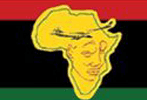A post-colonial visual meditation on archive, memory, and colonial violence.

The near-blinding white light hits you early in the film. Cinema goers grimace, cower or cover their eyes. A narrator hums a story in Spanish about a village, a chief and a tragedy that occurred a long time ago. The light slowly begins to fade revealing the outline of a non-descript image. Like a polaroid photograph, the outlines and shapes gradually become less washed out and opaque, shedding their milky indistinctiveness to briefly reveal an archival sliver, a picture or a fragment of a text, records from the Spanish colony of Equatorial Guinea (known as Fernando Poo prior to independence in 1968) on the island of Bioko from the early twentieth century.
This searing mise-en-scene, of light, of hypnotic voice overs, and of washed out archival fragments characterizes Javier Fernández Vázquez’s debut feature, Anunciaron tormenta, known in English as A Storm Is Coming. The film was inspired by the short film “The Embassy,” by Portuguese director Filipa César, which documents the scant archival records of the Portuguese colonial project in Guinea Bissau. It is a self-reflexive steadily paced documentary that reprises the circumstances behind the death of Chief Ësáasi Eweera, “one of the last kings of the Bubi people of the island of Bioko” in 1904. It is a film vested with a post-colonial politics of memory that reflects the director’s position on embracing the politics that comes with film making.
Here, Vázquez works with the Spanish archival record preserved by the Catholic Mission and the Spanish State, and the oral history and memory of the indigenous Bubis to interrogate the chief’s untimely death. To illustrate the Spanish account he uses white, male Spanish actors to read extracts of the record. Mostly, their backs are turned to the viewer, but when their faces are shown they are cloaked in shadows that crowd in the claustrophobic recording studio. Their dispassionate narration tells us about life in the village, the social and political conditions following the arrival of the Spanish and the unhappiness of the indigenous Bubi people who refuse to be ruled.
Repetitive and almost mind-numbing, the narration is suggestive of a historian painstakingly working their way through a repository that clings to its complex and difficult truths. We hear the Bubi chief arrived at the doctor’s barracks of his own accord. His people who mysteriously disappeared, did so voluntarily, leaving “for a better life” in another part of the colony. The doctor relates how ill the chief was upon arrival, and how, despite their best treatment, he died of natural causes. A colonial officer recounts them renaming him upon baptism just before his death.
As their clearly false, and sometimes absurd narrative unspools, white light regularly blitzes across the screen, as old photographs and yellowed documents are “revealed” to supplement a story that disintegrates in the very process of it coming together.
In Bioko, the director uncovers a different version of those times. He finds Bubi interlocutors who come forward to tell the passed down story of Spanish oppression, a lust for vengeance and the humiliating death of Chief Ësáasi Eweera. Whereas the Spanish narrators reveal their faces, the Bubis’, for the most part remain off-screen, keeping their faces hidden for cultural and political reasons. Theirs are disembodied voices that cut through scenes of the jungle where the village once was or bounce off the walls of dusty deteriorating haciendas that once housed Spanish colonial officials.
The Bubis tell a story of a massacre in the village at night, of the capture and enslavement of the women and children “for public service,” and of the arrest, imprisonment, and torture of their chief who they say resisted until the very end. It is a local story gathered at a site very near the historic location of the chief’s village. But it is narrated in Spanish, one further sign of how the presence of Spanish fundamentally disrupted indigenous linguistic and cultural life. The film conveys this troubled relationship between past and present through the juxtaposition of historical images of the village under Spanish rule with more contemporary footage that shows the entangled, yet also broken relationship between the two eras.
The narration, light, and juxtaposition of archival and present-day footage amplify the sense of tension freighted by driving metaphors of revelation and concealment that run throughout the film. Devices like sharp cuts and light serve as a poetic indictment of the self-assuredness of the colonial archival record as closed and true, showing it to be partial, unfinished, and even duplicitous in its claims to authority.
Once the matter of the chief’s death is concluded as having been unjust and left unpunished, the cinematic scope opens up, and the pace slows slightly to allow the Bubi to speak back. We’re introduced to the poet, historian and Bubi linguist, Justo Bolekia Boleká and his daughter, Reha-Xustina Bolekia Bueriberi, who jointly recite a Bubi poem, revealing in a very intimate way the inter-generational transmission of language and cultural knowledge. With the struggle for the recovery, growth, and development of the language still in its early stages, partly revived by Justo in 1986, the Bubi recovery from the historical trauma of colonial violence is still ongoing.
While we learn the truth of Chief Ësáasi Eweera’s death, the film does not entirely resolve the matter. Certainly, there is no justice forthcoming. Paying attention to the edges, the gaps, and the blank spaces in the assemblage of photographs and documents that bring his story home, the film also takes us beyond this case, to tell a bigger story about archive, language, and memory. Anunciaron tormenta is vertiginous in cinematic innovation, sensitive and moving; that is to say, it is a profound reflection on colonial violence brought to life as a gritty visual meditation on archive.
Anunciaron tormenta debuted at the 70th edition of the Berlinale Film Festival.

